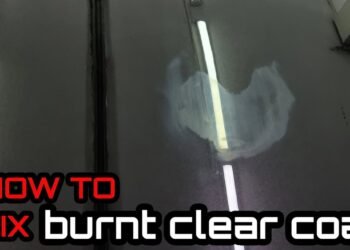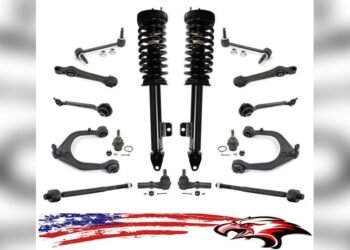Have you ever noticed tiny specks of clear coat overspray ruining the perfect look of your car’s glass? It’s frustrating, isn’t it?
Whether it happened during a paint job or from nearby work, clear coat overspray on glass can be tough to remove—and if you try the wrong method, you risk scratching or damaging your windows. But don’t worry, you’re in the right place.
You’ll discover simple, effective ways to safely get rid of clear coat overspray from your glass surfaces. Keep reading, and you’ll learn how to restore the crystal-clear shine your car deserves without any hassle or damage.
Tools And Materials Needed
Removing clear coat overspray from glass requires specific tools and materials. Using the right items makes the process easier and safer. Prepare all tools before starting to avoid interruptions. Each tool serves a unique purpose in cleaning the glass effectively.
Razor Blades And Safety Tips
A sharp razor blade helps scrape off overspray from glass. Hold the blade at a low angle to avoid scratches. Use a new blade to ensure clean cuts. Always wear gloves to protect your hands. Keep the glass wet with a lubricant to reduce friction. Move the blade gently and slowly across the surface. Avoid pressing too hard to prevent damage.
Clay Bars And Lubricants
Clay bars work well to lift overspray without scratching. Spray the glass with a lubricant before using the clay bar. Use soapy water or a special clay lubricant for smooth movement. Rub the clay bar in circular motions on the glass. The overspray sticks to the clay, leaving the surface smooth. Wipe the glass clean with a microfiber cloth after.
Chemical Removers And Cleaners
Chemical removers break down the clear coat overspray for easy cleaning. Apply the remover to the affected area and let it soak. Follow the product instructions for the best results. Use gentle cleaners designed for glass to avoid damage. Test the chemical on a small area first to check for safety. Wipe off the residue with a clean cloth after treatment.
Microfiber Cloths
Microfiber cloths are essential for cleaning and drying glass surfaces. They absorb liquids well and reduce streaks. Use a clean microfiber cloth to wipe off chemicals and overspray residue. Avoid using rough or dirty cloths that can scratch the glass. Wash microfiber cloths regularly to keep them effective. Soft cloths help achieve a clear, polished finish.

Credit: www.reddit.com
Preparing The Glass Surface
Preparing the glass surface is the first step to remove clear coat overspray effectively. It ensures the cleaning process works well and avoids damage to the glass. Proper preparation helps loosen the overspray and makes removal easier. Take time to clean and test before applying any product.
Cleaning And Lubricating
Start by cleaning the glass with a mild detergent or window cleaner. This removes dirt and dust that can cause scratches. Use a soft cloth or sponge to avoid damage. Next, apply a lubricant like soapy water or a clay lubricant spray. Lubricating the surface reduces friction during removal and protects the glass from scratches.
Testing Products On A Small Area
Always test any remover or cleaner on a small, hidden spot first. This checks for adverse reactions like discoloration or damage. Apply the product gently and wait a few minutes. Observe the area for any changes. Testing helps you choose the safest product and avoid costly mistakes on the whole glass surface.
Removing Overspray With A Razor Blade
Removing clear coat overspray from glass can be tricky. A razor blade helps remove it safely and effectively. This tool allows precise control, making it easier to scrape the overspray without damaging the glass. Use it carefully for best results.
Holding The Blade Correctly
Hold the razor blade at a low angle, nearly flat against the glass. This reduces the risk of scratches. Grip the handle firmly but gently. Make sure the blade is sharp and clean for smooth scraping. Replace the blade if it becomes dull or chipped.
Gentle Scraping Techniques
Start scraping slowly and lightly. Use short, smooth strokes to lift the overspray. Do not press hard; this can scratch the glass. Keep the surface wet with soapy water or a glass cleaner. This helps the blade glide and reduces damage.
Wiping And Inspecting The Glass
After scraping, wipe the glass with a clean microfiber cloth. Check for any remaining overspray or scratches. Repeat scraping gently if needed, always keeping the glass wet. Finish by drying the glass completely to reveal a clear, clean surface.

Credit: www.reddit.com
Using A Clay Bar For Overspray Removal
Using a clay bar is a gentle and effective way to remove clear coat overspray from glass surfaces. This method helps lift the unwanted paint particles without scratching the glass. The clay bar works by picking up contaminants that simple washing cannot remove. It leaves the glass feeling smooth and clear.
The process requires some preparation and care to avoid damage. Lubrication is key to ensure the clay bar glides smoothly over the glass. Patience during rubbing helps remove the overspray evenly. Finally, cleaning off any residue restores the glass to its original shine.
Applying Lubricant
Spray a clay lubricant or soapy water on the glass surface. Cover the entire area with overspray generously. The lubricant prevents the clay bar from sticking or scratching the glass. Keep the surface wet throughout the process. This step makes the clay bar glide easily.
Rubbing The Clay Bar
Take a small piece of clay bar and flatten it slightly. Rub the clay bar gently over the lubricated glass using circular motions. Focus on the overspray spots but cover the whole area for even cleaning. The clay traps the overspray paint as you move it. Avoid pressing too hard to protect the glass.
Cleaning Residue
After rubbing, wipe the glass with a clean microfiber cloth. Remove any clay lubricant and loosened overspray paint. Check the glass for smoothness and clarity. Repeat the process if some overspray remains. Finish by drying the glass to prevent streaks or spots.
Chemical Remover Methods
Chemical remover methods offer an effective way to eliminate clear coat overspray from glass surfaces. These solutions break down the overspray, making it easier to remove without damaging the glass. Using chemical removers requires care and proper technique to achieve the best results and protect the glass.
Applying The Remover
Start by selecting a remover designed for clear coat overspray. Apply a small amount of the chemical remover directly onto the affected glass area. Use a soft cloth or sponge to spread the product evenly. Avoid using too much liquid to prevent drips or runoff.
Soaking Time And Safety
Allow the remover to soak on the glass for the time specified on the product label. This usually ranges from a few minutes to ten minutes. Soaking helps dissolve the overspray for easier removal. Wear gloves and ensure good ventilation to protect your skin and lungs from fumes.
Wiping And Final Cleaning
After soaking, gently wipe the overspray away using a clean microfiber cloth. Use light pressure to avoid scratching the glass. Repeat the application if needed for stubborn spots. Finish by cleaning the glass with soapy water or window cleaner to remove any residue.

Credit: fastplus.eu
Preventing Scratches And Damage
Removing clear coat overspray from glass requires care to prevent scratches and damage. The glass surface is delicate and can easily get marred by harsh methods or wrong tools. Protecting the glass ensures a smooth, clear finish without costly repairs. Follow these simple tips to keep your glass safe and clean during the removal process.
Avoiding Dry Scraping
Never scrape the glass when it is dry. Dry scraping can cause tiny scratches that build up over time. Always wet the surface with soapy water or a glass cleaner before scraping. This lubrication reduces friction and helps the blade glide smoothly. Keep the area wet while working to avoid damage.
Choosing The Right Tools
Select tools designed for glass care. Use a sharp razor blade held at a low angle to gently lift the overspray. Avoid dull or chipped blades that can scratch the surface. Soft microfiber cloths work best for wiping away residue. Avoid rough materials that may leave marks or fibers behind.
Working In Small Sections
Focus on small areas one at a time. This method gives better control and reduces the risk of applying too much pressure. It also helps keep the cleaning solution fresh and effective on the glass. Take breaks to check progress and adjust your technique as needed for the best results.
Troubleshooting Common Issues
Removing clear coat overspray from glass can be tricky. Sometimes simple methods do not work well. Common issues might slow down your progress or cause damage. Understanding these problems helps you fix them safely and quickly.
This section covers solutions for stubborn spots, large areas, and when it is best to call a professional. Follow these tips to avoid scratches or wasting time.
Stubborn Overspray Spots
Some overspray spots stick tightly to the glass. They do not come off with water or gentle cleaning. Use a razor blade carefully at a low angle. Always keep the glass wet to avoid scratches. If the spot remains, try a clay bar with lubricant. Rub gently in circles until smooth. Avoid harsh scrubbing that could damage the glass surface.
Handling Large Areas
Large overspray patches need more time and effort. Work in small sections to control the process better. Spray a soapy water solution to keep the glass wet. Use a clay bar or chemical remover designed for glass surfaces. Always follow the product instructions. Wipe clean often to see your progress. This method prevents uneven cleaning and reduces the risk of damage.
When To Seek Professional Help
Some overspray problems require expert care. Deep or widespread damage is hard to fix alone. Professionals have special tools and safe chemicals. They can remove overspray without harming your glass. Choose professional help if DIY methods fail or the glass looks scratched. It saves time and protects your windows from costly repairs.
Maintenance Tips For Glass Care
Proper care extends the life and clarity of your glass surfaces. Maintenance prevents damage and keeps glass looking clean. Follow simple steps to protect glass from overspray and wear.
Regular Cleaning Routine
Clean glass often using a soft cloth and mild cleaner. Avoid harsh chemicals that can damage the surface. Use warm water mixed with a small amount of dish soap. Wipe gently to remove dirt and grime. Dry with a microfiber cloth to prevent streaks.
Protective Coatings
Apply a glass sealant to protect from dirt and overspray. Protective coatings create a barrier against contaminants. Reapply coatings every few months for best results. These coatings also make cleaning easier and improve clarity.
Avoiding Future Overspray
Cover glass surfaces during painting or spraying projects. Use plastic sheets or painter’s tape to shield glass edges. Work carefully to reduce chances of overspray. Clean any accidental overspray quickly to prevent buildup.
Frequently Asked Questions
How To Get Clear Coat Overspray Off Glass?
Spray soapy water on the glass to lubricate. Gently scrape overspray with a sharp razor blade at a low angle. Use a clay bar with lubricant for stubborn spots. Apply chemical remover carefully, then wipe clean with a microfiber cloth.
Always test products first to avoid damage.
How To Take Overspray Off Glasses?
Spray soapy water or glass cleaner on the overspray. Use a sharp razor blade at a low angle to gently scrape it off. Alternatively, rub a lubricated clay bar over the area. Wipe clean with a microfiber cloth. Always test first to avoid damage.
How To Remove Overspray Clear Coat From Car?
Spray soapy water or glass cleaner on overspray. Gently scrape with a sharp razor blade at a low angle. Use a clay bar with lubricant for stubborn spots. Apply chemical remover if needed, then wipe clean with a microfiber cloth.
Always test products on a small area first.
How Do You Get Spray Paint Off Glass?
Spray the glass with soapy water or glass cleaner. Use a sharp razor blade at a low angle to gently scrape off paint. Alternatively, rub with a lubricated clay bar or apply a paint remover. Always test first and wipe clean with a microfiber cloth.
What Is Clear Coat Overspray On Glass?
Clear coat overspray is unwanted paint mist that lands and dries on glass surfaces.
Conclusion
Removing clear coat overspray from glass requires care and patience. Use gentle tools like razor blades or clay bars with proper lubrication. Chemical removers can help but test them on small areas first. Always clean the glass thoroughly afterward to avoid residue.
Taking these steps protects your glass and keeps it clear. Clean glass improves visibility and maintains your vehicle’s appearance. With the right approach, overspray removal becomes manageable and safe. Keep your glass spotless and enjoy a clearer view every day.

















